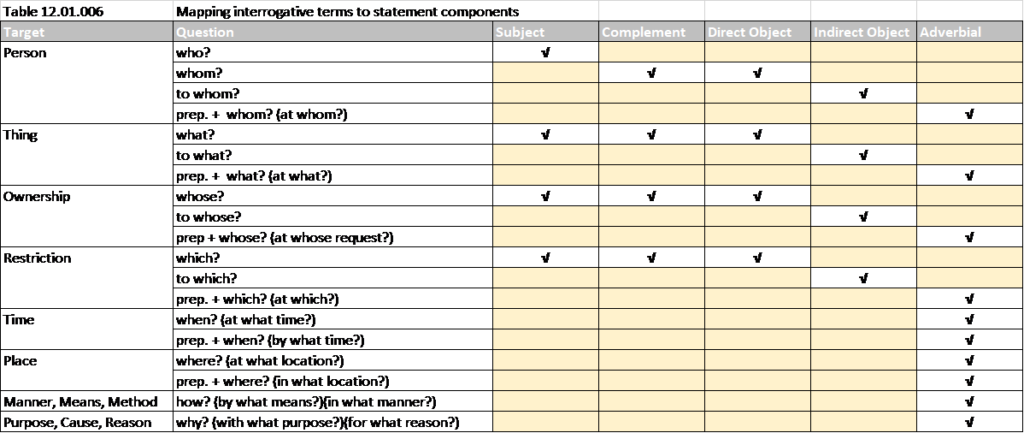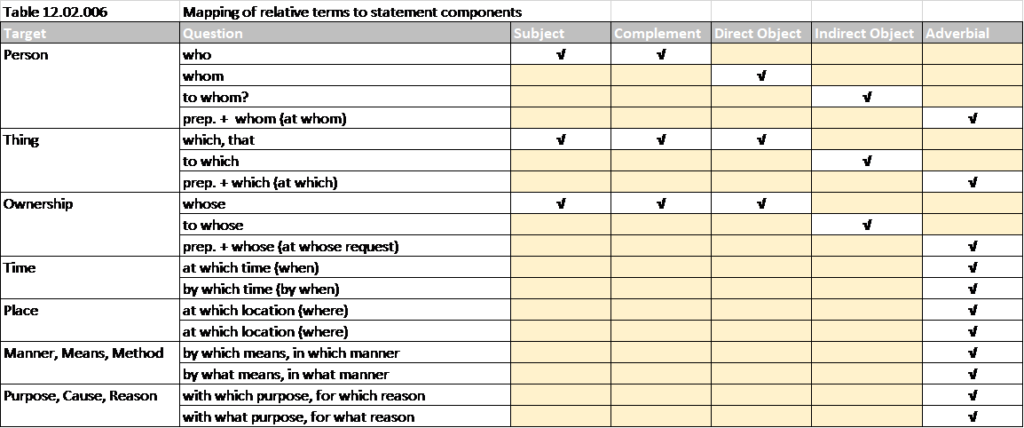These structures can be dealt with together for a number of reasons. Firstly, there is a significant overlap between interrogative pronouns, adjectives and adverbs and relative pronouns, adjectives and adverbs. Secondly, despite this, these terms function differently for reasons which are not immediately obvious. Thirdly, in both cases, the same ambiguity regarding the classification of terms arises; which terms are pronouns, which adjectives and which adverbs, and what is the basis for the classification. We can go further an ask how useful the classification is and whether these cases point to an underlying limitation.
Question terms
The target of a question may be any aspect of state or event: people, things, attributes and relations, time and place, means, method or manner and ground, purpose or reason. The classification of terms reflects these differences: interrogative pronouns target people and things, interrogative adjectives target attributes and relations, and interrogative adverbs target time and place, manner and reason.

Whether or not who or whom is used for people depends on the statement component. If the target of the question is the subject, then who is used. If the target is a direct object or complement then whom is used. For indirect object the question will be to whom and for adverbials it will be a prepositional phrase such as by whom or for whom. With regard to things, the form is invariable: what, to what and by what or for what.
The following examples are taken from an imagined scenario where a patient is admitted to hospital for emergency treatment.

Adjectives can be used either descriptively or restrictively. Typically, a question such as whose book, which book or what book will be seeking information to narrow down the reference, and so will be targeting the restrictive use of adjectives. Which and what can be used interchangeably as interrogative adjectives, though which tends to flow better.

Times and places, the when and the where of a situation, are interrogated through the use of adverbs. This is not always readily apparent because the questions can easily be elided. For this reason, they may appear to have the same form as pronouns. However, when is and where is are really short forms of at what time is and at what place is and the response will be found in an adverbial, even if it is, like here and now, not an adverb but a noun.

Similarly, questions about manner, means, & method and reason, ground & purpose; questions about how and why; are formed using adverbs and answered in the adverbial component of a statement. As in the case of time and place, the how and the why are fundamentally prepositional phrases, for example: in what manner or for what purpose. Reasons and purposes may be answered in a subordinate clause, introduced by the conjunction because.

In summary, who, whom, whose, what and which are questions that will be answered by the contents of the subject, the complement and the direct object of the response. On the other hand, when, where, how and why, are questions that will be answered in the adverbial component. The prepositional forms of whom, whose, what and which, which give English the equivalent to a case structure, will be answered in the adverbial component, with the exception that the dative case equivalent, to whom, to whose, to what and to which, may be answered in the indirect object.

It’s possible that the more indeterminate version of each interrogative term may be used as an alternative. These versions tend to convey not just a question but also a level of surprise: whoever can that be, whatever can that mean, wherever can they be or however did that happen.

Relative Terms
A relative clause is a statement that refers back to an antecedent term in another clause. It is used either to restrict the reference of the antecedent term or to provide more information about it. A restrictive relative clause narrows the target reference. In this example, the house being talked about is the house that they live in now.

In the non-restrictive clause, the fact that it was in countryside at that time they bought it is additional information about the antecedent rather than information that defines it. In the restrictive clause, the additional information restricts the reference so that we know it was this house and not some other house.
Relative terms follow a somewhat similar pattern to interrogative terms. However, there are some differences. Because relative clauses have a similar function to adjectives, the adjectival forms whose and which become pronouns and which and that are used instead of what to refer to things.

These examples are taken from the same scenario where a patient is admitted to hospital for emergency treatment.

Times and places may also be the antecedent.

Prepositional phrases can be used to refer back to an antecedent manner, means or method or reason, ground or purpose. The terms how and why themselves are interrogative and can’t themselves be used as relative adverbs.

When the antecedent is the means, method or manner, or the reason, purpose or explanation, the relative clause is headed by a preposition plus which as in, for example, the means by which… or the reason for which. Reasons are often given in separate clauses headed by the conjunctions because and for, or as prepositional phrases such as in order to; as a consequence of; because of and so on.

As is the case with questions, the more indeterminate forms can be used. It is also possible for the longer form to be used, implying not only a lack of definition but also a level of conditionality.


So, for example, the term who is used when the antecedent is well defined, whoever is used when the antecedent is less clearly defined and whosoever is used when the antecedent is both not clearly defined and has an element of conditionality.

